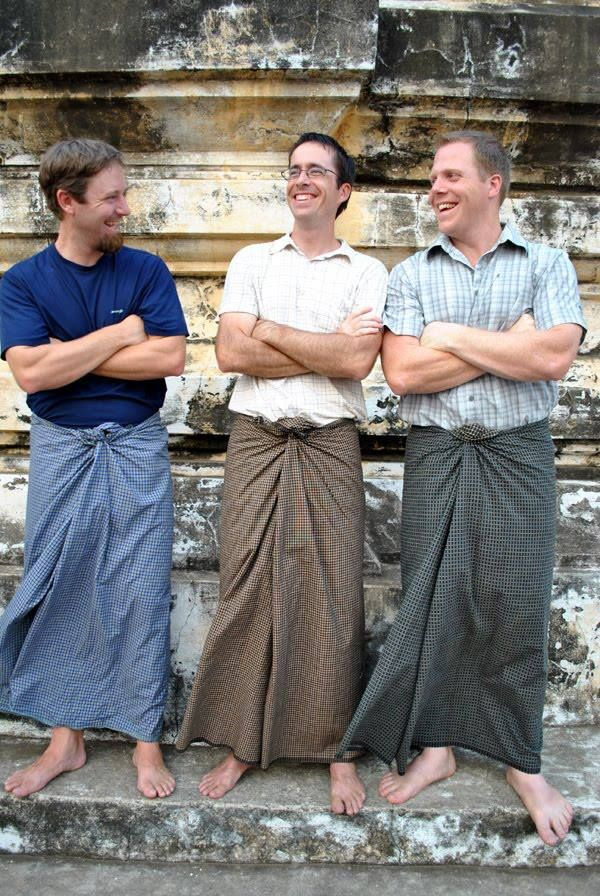Myanmar, formerly known as “Hongsawadi,” is a fascinating Southeast Asian country with a rich history and unique cultural traditions. Despite its abundant natural resources, it remains one of the least developed countries, largely relying on agriculture. Covering 676,581 square kilometers and home to over 53 million people, Myanmar’s capital was relocated from Yangon to Naypyidaw in 2005.
1. Buddhism and Monastic Life
Over 80% of Myanmar’s population follows Theravāda Buddhism. Unlike Mahāyāna Buddhism, which is more common in China, Myanmar monks are allowed to eat meat as long as it meets the “threefold purity” rule—meaning they neither saw nor heard the animal being killed, and it was not slaughtered specifically for them. Monastic life is highly respected, and it is customary for boys between the ages of 5 and 15 to spend time as novice monks. This is considered a rite of passage, and a man’s life is incomplete without it.
2. Traditional Attire: The Elegant “Longyi”
In Myanmar, men and women both wear a wraparound skirt called a “longyi.” The men’s version is tied at the front, while women tie theirs at the side. This comfortable and practical attire is worn for both casual and formal occasions, often featuring vibrant colors and intricate patterns.

3. A Unique Calendar and Zodiac System
A week in Myanmar consists of eight days, as Wednesday is divided into two halves—morning and afternoon. Additionally, Myanmar has an eight-animal zodiac system, where each day corresponds to a different creature. For instance, those born on Monday are associated with the tiger, while those born on Sunday are linked to the mythical Garuda bird. Incredibly, birthdays are celebrated weekly, meaning people have 52 birthdays a year!
4. The Gemstone Capital of the World
Myanmar is renowned for its jade and rubies. While much of the world’s jade supply comes from Myanmar’s Mogok region, the country’s national gemstone is actually the ruby. The famed “pigeon’s blood” rubies from Mogok are considered some of the finest in the world.
5. Right vs. Left: A Cultural Distinction
In Myanmar, the right side is considered superior to the left. This belief influences many aspects of daily life, including seating arrangements, where men sit on the right and women on the left. Additionally, touching someone’s head—even a child’s—is seen as disrespectful.
6. The Mystery of Thanaka
Walk through the streets of Myanmar, and you’ll notice many people, especially women and children, wearing a yellowish paste on their faces. This is “Thanaka,” a natural sunscreen and beauty treatment made from ground tree bark, used for over 2,400 years.
7. Tea Culture: More Than Just a Beverage
Tea in Myanmar is not only for drinking—it is also eaten! The country’s famous “laphet thoke,” or tea leaf salad, is a popular dish combining pickled tea leaves with crunchy nuts, garlic, and chili. Myanmar is one of the few places in the world where tea is consumed in both liquid and solid form.
8. Ancient Sports: Chinlone
Myanmar’s traditional sport, “Chinlone,” is a graceful and artistic game similar to sepak takraw. Players use their feet, head, knees, and shoulders to keep a rattan ball in the air, blending dance-like movements with precise control.
9. The Sea Nomads of Myanmar
Along the country’s coast live the “Moken” people, often called “Sea Gypsies.” These semi-nomadic people have remarkable underwater vision, allowing them to dive deep without modern equipment. They primarily inhabit the Mergui Archipelago and sustain themselves through fishing.
10. The Grand Shwedagon Pagoda
The Shwedagon Pagoda in Yangon is Myanmar’s most sacred religious site. Its golden stupa is adorned with over 7,000 precious stones, including diamonds, rubies, and sapphires, and it is said to contain relics of four Buddhas. Visitors must remove their shoes before entering as a sign of respect.
11. The Land of Countless Pagodas
Myanmar’s landscape is dotted with thousands of pagodas, many of which are privately funded. In fact, around 85% of the pagodas were built using personal donations. Rather than saving money for material wealth, many Burmese people prioritize constructing religious monuments as an act of merit.
12. The Influence of Burmese Culture Today
Despite modernization, Myanmar holds strong to its traditions. The importance of Buddhism, traditional dress, and cultural customs remain deeply embedded in daily life. As global interest in sustainable tourism grows, Myanmar’s unique customs—such as eating tea, wearing Thanaka, and practicing Chinlone—offer a fascinating glimpse into a culture that continues to thrive while adapting to the modern world.
Myanmar’s history is also deeply intertwined with its neighboring countries. Throughout its past, Myanmar engaged in frequent conflicts with Thailand and was once part of the Mongol Empire’s expansion under Kublai Khan. The country has undergone various dynastic changes, from the Pagan Empire to the Toungoo and Konbaung dynasties, each leaving a lasting impact on its culture and architecture.
As Myanmar continues to navigate modernization while preserving its deep-rooted traditions, its unique blend of history, religion, and cultural identity makes it a compelling destination for travelers and historians alike.

No comments yet.